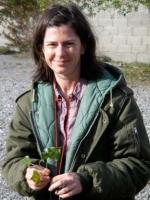
Work Package Biodiversity and ecosystems
Introduction
What makes a system resilient, and how can we manage for resilience?
Biodiversity, the variety of life on earth, provides us with much of what we need to live, yet biodiversity is being lost at an unprecedented rate with adverse effects on the natural world and society. Understanding how species and ecosystems are likely to respond and finding ways of increasing their resilience is necessary to inform policy and management. The work here aims to increase our understanding of how species and biological communities may respond to land use and climate change, and how we can increase the resilience of these communities alongside human activity.
Aim of Research
Resilience of ecosystems and biodiversity. This work aims to study the different aspects of resilience of widlife species and natural ecosystems to improve our understanding of how biodiversity and ecosystems are likely to change in response to environmental and climate change, and how to manage them to increase their resilience to change.
Progress
Continuing work from year 5 research on frost tolerance in native pine trees from different parts of Scotland and the analysis of data have been completed. Although an effect of frost damage was detected, this was similar across all Scots pine populations. These findings have been shared with project partners and have been written up for publication and as a Research Summary. The collaboration that has developed between project partners was successful in leveraging a significant NERC Treescapes grant (£2.3 million). Researchers investigating Phytophthora resistance in pines have successfully grown pine trees with different genetic resistance to infection which will be available for use in future research on natural resistance to Phytophthora infection. Some seedlings will be grown on for another 12 months before planting into common garden experimental sites. Field work assessing liver fluke infection in livestock concluded this year. Samples have been archived, and the data used to produce Case Study on Fluke Risk & Conservation Grazing. Our researcher has continued to inform Scottish Wildlife Trust's Saving Scotland's Red Squirrels Project and inform the discussion on the potential use of gene drive technology to control grey squirrels. The results from this work have contributed to a report on how monitoring can help to detect the early presence of squirrelpox, and how you can be proactive in reducing its impact.
New work undertaken this year included ongoing assessment of aerial imagery to map the extent of muirbun across Scotland. This muirburn data was then combined with species occurrence data to map the distribution of occurrence records of adder, common lizard, common frog and common toad in relation to muirburn. and the percentage area of 1 km square cells. Work on the distribution of mountain hares in relation to land use and the likely effect of woodland expansion in the Cairngorm National Park was also completed and a manuscript submitted for publication. We also undertook research on the association between tree planting and microbial diversity at the James Hutton Institute’s Glensaugh Research Farm. The results from molecular analysis of water samples indicated that most were positive for Phytophthora and other oomycetes. Scientists also undertook a synthesis of expert opinion of how green recovery schemes such as woodland creation, improving biodiversity and nature-based prescriptions may have unexpected consequences for tick-borne disease risk, and the results published as a book chapter.
Highlights:
- Lack of tree species diversity in semi-natural woodlands leads to lack of resilience: Work in this area by researchers in SEFARI and Forest Research is being used to advise Defra through its Tree and Woodland Science Advisory Group. A paper recently published in Journal of Ecology by SEFARI and FR scientists highlighted the importance of diverse tree species composition within woodlands to increase resilience. The work showed that if multiple tree species are lost from UK woodlands (oak and ash), the total number of associated species at risk of extirpation is greater than the sum of the associated species at risk from declines in either host alone. Ash hosts 45 obligate species (species only found on that host) and oak hosts 326. However, a decline in both these trees would impact 512 associated species, across multiple taxon groups, a 38% increase. In addition, many species that are not obligate on ash or oak are also at risk if oak and ash decline, as in many woodlands across the UK the other tree species that are known to support them are not present within the woodlands despite, in many instances, the soils and climate being suitable for such surrogates to grow. Defra Chief Plant Health Officer, Professor Nicola Spence, commented: “This work reiterates the importance of protecting our native trees. It confirms that the value of our interconnected ecosystems is often more than may immediately meet the eye, and the importance of intelligent woodland management plans to support resilience. Such combinatorial analysis is beneficial to our understanding and further development of an available ‘toolkit’”.
- Ecological implications of a decline in oak: SEFARI scientists working with Forest Research have recently published a Research Note outlining the implications on biodiversity and ecosystem functioning of a decline in UK native oak trees and management options to mitigate impacts.
- Liver fluke risk and agri-environment schemes: SEFARI scientists have been investigating the risk to livestock of grazing saltmarsh habitat to help conserve protected natterjack toad populations on the Solway Firth. Results would suggest the fluke risk to livestock is relatively low, but requires careful monitoring. The work has been written up as a case study for the SEFARI website and is currently being incorporated into a Conservation Grazing Guide for Farmers and Land Managers.
- Increasing resilience of trees and woodlands: Building on previous SRP funded work, SEFARI researchers have secured NERC funding for a project “Learning to adapt to an uncertain future: linking genes, trees, people and processes for more resilient treescapes (newLEAF)”. The project involving a multi-disciplinary collaboration with CEH, FR and the Universities of York, Strathclyde, Stirling, Glasgow and RGU will look at the capacity tree species have for adaptation and whether this can be realised in different situations and timeframes. Announcements of the six successful UK Treescapes projects were made on 9th August and have already generated considerable interest from practitioners and policy-makers.
We have continued work to on a range of high priority species and habitats to provide information on how these systems might change due to land use and climate change, how these changes might affect the resilience and functioning, and to provide evidence on how to mitigate these changes to promote biodiversity, resilience, and ecosystem functioning.
Research into the interaction between the establishment of wetland areas for wading bird conservation and the risk of liver fluke has shown that the risk to livestock in lower than previously thought and has been summarised as a SEFARI case study and podcast. Work on the functional and ecosystem services of different tree species has concluded with the publication of a reviewed paper. Research into the effects of climate change on high profile umbrella species has continued and resulted in the publication of two high impact peer reviewed publications on the effects of climate change on ticks and tick-borne diseases, and the timing of seasonal moult in mountain hares. Our work on the effects of land use change, in this case woodland expansion on mo0untai hares has progressed and will be written up in the coming year.
Cutting edge molecular techniques have been developed and used to detect antimicrobial resistant genes in marine wild mammals as a tool to allow rapid identification of microbial resistant species in the wildlife-livestock interface. Novel cameral trap techniques have also been developed to provide a rapid, low-cost, and non-invasive tool for monitoring small mammals. Our work on squirrelpox has continued to provide data to the Scottish Wildlife Trust to monitor the distribution and prevalence of this disease in free living red squirrel population. Other work on monitoring the distribution and diversity of Phytophthora species, the effects of restoration on peatland habitat composition, frost tolerance in Scots Pine has continued.
Highlights:
- Functional and ecosystem service differences between tree species: implications for tree species replacement. Globally, tree species composition is changing due to species loss from pests and pathogens. The impact of this change on ecological functioning is rarely tested. Using six sites across the UK, with multiple tree species at each site, we tested for functional differences between three species threatened by disease in the UK (our two native Oak species and Ash) and six other species which have been suggested as ecological replacement species (Sycamore, Sweet chestnut, Beech, Turkey oak, Red oak and Lime). Differences between species were detected for all the variables measured which link to the ecosystem services of nutrient cycling, climate and water regulation. For example, decomposition was faster under Ash than Beech and three of four Oak species, the temperature was cooler under Beech than Sycamore and Sweet chestnut bark held more water than the other tree species studied. The work, published as peer reviewed paper, highlighted that which species replaces diseased trees, even at the scale of single trees, will impact on the functions and ecosystem services provided.
- Liver fluke risk and agri-environment schemes: Wetland birds are in decline but establishment of wetland areas to promote their conservation has previously been thought to be incompatible with grazing animals due to the risk of liver fluke. However, SEFARI scientists have shown that the risk to livestock of catching liver fluke in these wetlands would appear to be lower than in the neighbouring in-bye fields. Results are summarised in a SEFARI Case Study and associated podcast.
- New approach to assess carriage of antimicrobial resistance genes by a marine sentinel species: SEFARI scientists have successfully applied cutting-edge DNA sequencing technologies to detect antimicrobial resistance (AMR) genes in faecal samples from the Scottish grey seal, which is an important indicator species of environmental contamination. The method employs Nanopore technology and also allows rapid identification of the bacteria that carry the AMR genes, shedding light on potential routes of environmental contamination and the spread of AMR genes at the wildlife–livestock interface. The work was presented at the 6th World One Health Congress (Virtual Edition).
- Moult and climate change: Research by SEFARI scientists in collaboration with colleagues in America showed increased camouflage mismatch in mountain hares due to climate change. Despite on average there being 35 fewer snow days per year compared to 70 years ago, mountain hares have not adapted the timing of either their autumn or spring moults.
- Small mammal monitoring: Working with colleagues from the RSPB and the Mammal Society, SEFARI scientists have developed an innovative camera trapping technique to study small mammal populations. The technique provides a low-cost survey method for small mammals that is labour-efficient and has minimal animal welfare implications.
We have continued to work on high priority species and habitats to better understand how global change, biodiversity, and management interact and affect the resilience of species and ecological systems.
We have used field, laboratory and modelling studies to assess how important pathogens, such as Phytophthora, liver fluke, Campylobacter and squirrel pox virus, are distributed in the landscape and are affected by land management and climate change. Applying a novel DNA barcoding method to eDNA samples has improved our knowledge of the distribution of Phytophthora species across Scotland which will help inform plant health policies. Continued monitoring of squirrel pox virus has shown no significant spread but has allowed informed advice on the rehoming of orphaned red squirrels for example.
With the spread of tree diseases and the associated decline of ash and oak trees in the UK landscape, we are investigating how alternative tree species might replace trees lost due to tree pests and diseases. An experimental system to investigate the impacts of pathogens threatening biodiversity on British conifers has begun and has already fed into biosecurity discussions at an international level. Work on peatland restoration and the use of remote sensing to monitor recovery has also been ongoing. We have also continued to assess how the distribution of important species, for example Scots pine, mountain hares, and ticks, might be affected by land use and climate change. In the case of ticks, modelling has shown range shifts and therefore Lyme disease risk, is likely to increase in colder regions due to climate change.
Highlights:
- Managing oak woods in the face of oak decline: Our native oak trees are at risk of declining due to pests, disease and climate change. The impacts of this decline on biodiversity and ecosystem function have been identified and a list of all 2,300 species known to be found on oak have now been published. The results have been used in case studies to demonstrate how woodland managers can adapt their management to help conserve oak-associated biodiversity and ecosystem services.
- WaderMap: SEFARI scientists, in collaboration with the Working for Waders initiative and partners, have developed WaderMap: an online web app that enables stakeholders to interact with a map of management-relevant information and wader conservation initiatives and contribute data on their own wader conservation initiatives. Projects can be shown against various user-selectable backdrops that, for example show the current distribution of a species or target areas for AECS wader measures. This tool is being used by land-managers to develop landscape level collaborative management and to inform the development of results-orientated farm payments.
- Artificial ash tree habitat? SEFARI researchers have investigated the bark characteristics of ash trees and other tree species that might replace ash as ash trees decline due to ash dieback disease. The work aimed to identify the bark characteristics important in supporting lichens and bryophytes on ash and hence the suitability of other tree species as replacements. The work has recently been used by students at London University’s Imperial College design school to design artificial habitats similar to ash bark, that ash associated mosses and lichens could grow on.
Diseases can have profound effects on wildlife and domestic species of plants and animals. We have developed novel approaches to modelling the spread of pathogens in the environment and host species. We have carried out studies to better understand the occurrence and spread of Campylobacter in the Scottish seal population, squirrel pox in Scottish red squirrels, spread and risk from great spruce bark beetle and the dynamics between livestock grazing and liver fluke risk. Novel techniques developed earlier in the programme have been used to monitor the occurrence of Phytophthora, an important group of plant pathogens, and understand the factors that control its distribution and dispersal. In relation to tree diseases, significant data has been collected on the potential of alternative tree species to replace those species at risk of loss due to introduced pathogens. Targeted and longitudinal monitoring systems have been established to further study filamentous plant pathogens (comprised of fungi and Oomycetes or ‘water moulds’) in conservation translocation programmes and ex situ conservation (preservation of biological diversity outside their natural habitats).
We have also worked with stakeholders to develop tools to enable them to better understand how land use and climate change may affect the distribution of high-priority species. For example, CaperMap, a participatory Geographic Information System, was developed to enable agencies, local communities and outdoor recreationalists to interactively and graphically explore and assess the affects of human disturbance on the distribution of Capercaillie in multiuse landscapes. We have also added projected climate change data to that on current tick distribution and climate across Europe, and incorporated anthropogenic land use changes, to develop advanced models to produce algorithms that will pave the way for predictions of how tick range will shift according to climate and land use change.
The national scale peatland model has been published and we built a draft local model of the RSPB Forsinard reserve which suggests that restoration sites are developing towards the target state. This was further investigated using moderate-resolution satellite imagery, in conjunction with data from greenhouse gas monitoring, and suggested a return of the photosynthetic capacity to target levels in less than a decade. Our work on resilient pinewoods investigated the diversity of invertebrate species associated with Scots pine trees, and the role that geographic location, provenance and genetics have in determining these. In addition, we carried out further Scots pine seed collections to facilitate investigation of extreme weather tolerance in future years.
Highlights:
- Oak and ash biodiversity work used by Defra: Oak and ash are two of the most common British trees, but both are under threat from pests and diseases in addition to climate change. If oak and ash decline in abundance then species that use the trees may also decline, particularly if they are only found on oak or ash trees. In order to conserve the species associated with ash and oak we need to know which species use these trees and how ‘at risk’ they are if ash or oak decline. Data, complied by scientists at the James Hutton Institute, on the number of species found on oak and ash trees was recently used by Defra in its 2018 Tree Health Resilience Strategy and was presented at the opening meeting of the Plant Health Centre of Expertise.
- CaperMap: An engagement and communication tool to facilitate capercaillie conservation in multiuse woodlands. The final version of CaperMap was presented to stakeholders at a training event held at the Hutton at the beginning of this year. CaperMap is now assisting conservationists, local communities, and other stakeholders (e.g. SNH) to better understand how woodland can be managed to benefit outdoor users and capercaillie.
We developed and validated models which will allow a better understanding of how climate and land use change are likely to affect habitat condition and availability, and the distributions of diseases, and the mechanisms and organisms that spread them. Through workshops and literature reviews we have gained much better understandings of whole system resilience; how for example, coastal environments and pinewoods may or may not change in response to environmental change. We have developed new techniques to contribute to our understanding of plant pathogen prevalence and the risks of invasive species to natural species and ecosystems. Data and insights gathered on animal diseases has been shared with land owners to aid management and conservation strategies.
Highlights:
- CaperMap – a communication tool for Capercaillie conservation: A participatory GIS system – CaperMap – has been developed through collaboration with a range of stakeholders as a communication and engagement tool to promote Capercaillie conservation. The tool has now been handed over to, and is being used by, stakeholders (RSPB, SNH, CNPA). The principles behind ‘CaperMap’ will now be extended to other high conservation priority and policy relevant species.
- Modelling peatland condition using remote sensing: The possibility of monitoring peatland condition remotely, via satellite imagery, was tested. A model derived from Moderate Resolution Imaging Spectroradiometer (MODIS) data trained with ground observations from the Common Standard Monitoring data (SNH) was developed. The resulting model was relatively robust and has been validated against several independent datasets. Whilst not applicable for use at individual site level due to the relatively low resolution of the MODIS data, the work highlights potential to use satellite imagery for cost-effective condition monitoring with future developments likely as resolution improves. This work was highlighted in Royal Society of Edinburgh’s Science Scotland.
The initial synthesis of the concept of resilience from the scientific and stakeholder perspectives revealed a good degree of common understanding. This provides a suitable framework within which other work on other components such as diseases and their vectors, and their environmental consequences, and umbrella or foundation species will be considered in future years. The component system studies of resilience (woodlands and peatlands) have made significant progress in establishment of their methodologies, baseline data, or continued generation of results. New bodies of work on aspects of spread and biodiversity consequences of woodland and animal diseases have been established.
Highlights:
- Report on resilience concepts: A report on how resilience concepts can be applied to Scottish biodiversity has been completed and will form the basis of discussions with Scottish Natural Heritage to identify knowledge gaps.
- Capercaillie habitat suitability model: A participatory spatial model of habitat suitability for capercaillie has been developed to aid management choices to assist capercaillie conservation.
Future Activities
Going forward there will ongoing effort to publish our work, and to communicate results to stakeholders. In the new Strategic Research Programme scientists will build on work to date to, for example, assess how woodland restoration and expansion can be undertaken to maximise the flow of benefits and reduce risks, and how successful native woodland restoration is in delivering ecosystem functions. We will continue to assess the response of different pine populations to extreme stress, most notably drought, to predict provenances most suited to future climates. We will use the muirburn distribution map to start to explore how muirburn interacts with wildfire. We will also undertake new work to compare and contrast the effects of muirburn and mechanical cutting on aspects of ecosystem function. We will extend the work undertaken on mountain hare distributions and monitoring methods to develop non-invasive and genetic tools to provide both tools to monitor mountain hares in low density populations and woodland where traditional approaches are unsuitable, and to better understand the genetic diversity of the Scottish mountain hare population.
Selected Outputs
2017/18
- Muiruri, E.W., Barantal, S., Iason, G.R., Salminen, J-P., Perez-Fernandez, E., Koricheva, J. (2018) Forest diversity effects on insect herbivores: do leaf traits matter? New Phytologist, 221, 2250-2260.
- Barantal, S., Castagneyrol, B., Durka, W., Iason, G., Morath, S., Koricheva, J. (2019) Contrasting effects of tree species and genetic diversity on the leaf-miner communities associated with silver birch. Oecologia, 189, 687-697.
- Newey, S., Fletcher, K., Potts, J., Iason, G., 2018. Developing a counting methodology for mountain hares (Lepus timidus) in Scotland. Scottish Natural Heritage Research Report No. 1022. Inverness, Scotland.
- Peatlands: the long-term perspective. Science Scotland, Royal Society of Edinburgh.
- Henry, R.C., Palmer, S.C.F., Watts, K., Mitchell, R.J., Atkinson, N., Travis, J.M.J. (2017) Tree loss impacts on ecological connectivity: developing models for assessment. Ecological Informatics, 42, 90-99.
- Mitchell, R.J., Broome, A., Beaton, J.K., Bellamy, P.E., Ellis, C.J., Hester, A.J., Hodgetts, N.G., Iason, G.R., Littlewood, N.A., Newey, S., Pozsgai, G., Ramsay, S., Riach, D., Stockan, J.A., Taylor, A.F.S., Woodward, S. (2017) Challenges in assessing the ecological impacts of tree diseases and mitigation measures: the case of Hymenoscyphus fraxineus and Fraxinus excelsior. Baltic Forestry, 23, 116-140.
- Mitchell, R., Chitanava, S., Dbar, R., Kramarets, V., Lehtijärvi, A., Matchutadze, I., Mamadashvili, G., Matsiakh, I., Nacambo, S., Papazova-Anakieva, I., Sathyapala, S., Tuniyev, B., Vétek, G., Zukhbaia, M., Kenis, M. (2018) Identifying the ecological and societal consequences of a decline in Buxus spp. in Europe and the Caucasus. Biological Invasions.
- Broome, A., Mitchell, R.J. 2017 Ecological impacts of ash dieback and mitigation methods. Forestry Commission, Research Note FCRN029.
- Maclean, J.E., Mitchell, R.J., Burslem, D.F.R.P., Genney, D., Hall, J., Pakeman, R.J. (2018). Seed limitation, not soil legacy effects, prevents native understory from establishing in oak woodlands in Scotland after removal of Rhododendron ponticum. Restoration Ecology, 26, 865-872.
- Maclean, J.E., Mitchell, R.J., Burslem, D.F.R.P., Genney, D., Hall, J. and Pakeman, R.J. (2018) Invasion by Rhododendron ponticum depletes the native seed bank with long-term impacts after its removal. Biological Invasions, 20, 375-384.
- Maclean, J.E., Mitchell, R.J., Burslem, D.F.R.P., Genney, D., Hall, J. and Pakeman, R.J. (2017) Understorey plant community composition reflects its invasion history decades after invasive Rhododendron ponticum has been removed. Journal of Applied Ecology, 55, 874-884.
- Maclean, J.E., Mitchell, R.J., Burslem, D.F.R.P., Genney, D., Hall, J. and Pakeman, R.J. (2017) The epiphytic bryophyte community of Atlantic oak woodlands shows clear signs of recovery following the removal of invasive Rhododendron ponticum. Biological Conservation, 212, 96-104.
- Mitchell, R.J., Hewison, R.L., Fielding, D.A., Fisher, J.M., Gilbert, D.J., Hurskainen, S., Pakeman, R.J., Potts, J.M., Riach, D. (2018) Decline in atmospheric sulphur deposition and changes in climate are the major drivers of long-term change in grassland plant communities in Scotland. Environmental pollution, 235, 966-964
2018/19
- Artz, R.R.E., Johnson, S., Bruneau, P., Britton, A.J., Mitchell, R.J., Ross, L., Donaldson-Selby, G., Donnelly, D., Aitkenhead, M.J., Gimona, A., Poggio, L. (2019) The potential for modelling peatland habitat condition in Scotland using long-term MODIS data. Science of the Total Environment, 660, 429-442.
- Poggio, L.; Gimona, A.; Bruneau, P.; Johnson, S.; McBride, A.; Artz, R.R.E. (2018) Mapping of peatland conditions in Scotland. Conference Abstract, European Geosciences Union (EGU) General Assembly, Vienna, Austria, 8-13 April 2018.
- Lees, K.J., Quaife, T., Artz, R.R.E., Khomik, M., Clark, J. (2018) Potential for using remote sensing to estimate carbon fluxes across Northern peatlands. Science of the Total Environment, 615, 857-874.
- Broome, A., Ray, D., Mitchell, R., Harmer, R. (2019). Responding to ash dieback (Hymenoscyphus fraxineus) in the UK: woodland composition and replacement tree species. Forestry, 92, 108-119
- Mitchell, R.J., Bellamy, P.E., Ellis, C.J., Hewison, R.L., Hodgetts, N.G., Iason, G.R., Littlewood, N.A., Newey, S., Stockan, J.A., Taylor, A.F.S. (2019). Oak-associated biodiversity in the UK (OakEcol). NERC Environmental Information Data Centre.
2019/20
- Artz, R. (2019) Mapping peatlands remotely -resolution, scale and the quality of ground observations for model training determine the outcome. Pp. 13, Keynote presentation: WETSCAPES conference, Rostock, 10 - 13 September, 2019.
- Artz, R.; Ball, J.; Smart, C.; Donaldson-Selby, G.; Cowie, N.; Hancock, D.; Gimona, A. (2020) Peatland restoration age (Scotland, UK) can be better reproduced by a classification model based on Sentinel-2 than with high resolution aerial imagery Conference presentation at Flow Country conference 6, 16-18/3/2020.
- Cooke, D.E.L; Randall, E; Clark, B; Thorpe, P; Cock, P.J.; Pritchard, L.:, Pettitt, T.; Frederickson-Matika, D,; Green, S. (2019) Phytophthora eDNA barcoding for natural ecosystem surveillance. Proceedings of the Oomycete Molecular Genetics Network, 10-12 July 2019. SAMS, Oban, Scotland. PP13.
- Hayden, K. (2020). Botanic gardens and plant pathogens: A risk-based approach at the Royal Botanic Garden Edinburgh. Sibbaldia, 18 (Special Issue: Plant Health), 127–139.
- Hayden, K. (2020) Biosecurity beyond quarantine: themes from the 2020 plant health issue of Sibbaldia. BGJournal 17(1), 40-42
- Lees, K.J.; Quaife, T.; Artz, R.R.E.; Khomik, M.; Sottocornola, M.; Kiely, G.; Hambley, G.; Hill, T.; Saunders, M.; Cowie, N.R.; Ritson, J.; Clark, J.M. (2019) A model of gross primary productivity based on satellite data suggests formerly afforested peatlands undergoing restoration regain full photosynthesis capacity after five to ten years. Journal of Environmental Management, 246, 594-604.
- Lees, K.; Artz, R.R.E.; Khomik, M.; Clark, J.; Ritson, J.; Hancock, M.; Cowie, N.; Quaife, T. (2020) Using Spectral Indices to Estimate Water Content and GPP in Sphagnum Moss and Other Peatland Vegetation, IEEE Transactions on Geoscience and Remote Sensing 58(7), pp. 4557-4557.
- Newey, S.; Potts, J.: Aebischer, A.; Wilson, MW.; Newson, SE (2020) Designing a monitoring scheme for mountain hare (Lepus timidus) in Scotland. SNH Commissioned Research Report 1076.
- Pravia, A.; Andersen, R.; Artz, R.R.E.; Pakeman, R.J.; Littlewood, N.A. (2019) Restoration trajectory of carabid functional traits in a formerly afforested blanket bog. Acta Zoologica Academiaea Scientiarum Hungaricae, 65, 33-56.
2020/21
- Barwell, L.J.; Perez-Sierra, A.; Henricot, B.; Harris, A.; Burgess, T.I.; Hardy, G.; Scott, P.; Williams, N.; Cooke, D.E.L.; Green, S.; Chapman, D.S.; Purse, B.V. (2021) Evolutionary trait-based approaches for predicting future global impacts of plant pathogens in the genus Phytophthora. Journal of Applied Ecology 58/4:718-730.
- Gilbert, L (2021) The impacts of climate change on ticks and tick-borne disease risk. Annual Review of Entomology 66:373-388.
- Hodgetts, N.G.; Iason, G.R.; Littlewood, N.A.; Newey, S.; Stockan, J.A.; Taylor, A.F.S. (2019). Oak-associated biodiversity in the UK (OakEcol). NERC Environmental Information Data Centre.
- Lees, K. J., Khomik, M., Quaife, T., Clark, J. M., Hill, T., Klein, D., Ritson, J., & Artz, R. (2021). Assessing the reliability of peatland GPP measurements by remote sensing: From plot to landscape scale. The Science of the total environment, 766, 142613.
- Lees, K.; Artz, R.R.E.; Chandler, D.; Aspinall, T.; Boulton, C.; Buxton, J.; Lenton, T. (2021) Using remote sensing to assess peatland resilience by estimating surface moisture and drought recovery. Science of the Total Environment 2021
- Littlewood, N.A.; Hancock, M.H.; Newey, S.; Shackelfood, G.; Toney, R. (2021) Use of a novel camera trapping approach to measure small mammal responses to peatland restoration. European Journal of Wildlife Research 67, Article number 12 (2021).
- Mitchell RJ, Hewison RL, Haghi RK, Robertson AHJ, Main AM, Owen IJ (2021) Functional and ecosystem service differences between tree species: implications for tree species replacement. Trees Structure and Function, 35, 307-317.
- Mitchell, R.J.; Hewison, R.L.; Beaton, J.; Haghi, R.K.; Robertson, A.H.J.; Main, A.M.; Owen, I.J.; Douglass, J. (2020). Functional and epiphytic biodiversity differences between nine tree species in the UK. NERC Environmental Information Data Centre.
- Pravia, A.; Andersen, R.; Artz, R.R.E.; Boyd, K.; Cowie, N.R.; Littlewood, N.A. (2020) Moth responses to forest-to-bog restoration. Mires and Peat 26, Artcile 27, 19 pp.
- Zimova, M., Giery, S.T., Newey, S., Nowak, J.J., Spencer, M., Mills, L.S., 2020. Lack of phenological shift leads to increased camouflage mismatch in mountain hares. Proc. R. Soc.
2021/22
- Perry, A; Beaton, J; Iason, G.; Cottrell, J.; Stockan, J.; Cavers, S. (2021). Long-term multi-site Scots pine single nucleotide polymorphism (SNP) genotypes and phenotypes for marker-trait association analysis. NERC EDS Environmental Information Data Centre.
- Perry, A; Wachowiak, W; Beaton, J; Iason, G; Cottrell, J; Cavers, S. (2022) Identifying and testing marker-trait associations for growth and phenology in three pine species: implications for genomic prediction. Ecological Applications.
- Weatherhill, A.S.; Coomber, F.G.; Darvill, B.; Hesford, N.; Le Marquand, C.; Macleod, R.; Mathews, F.; Newey, S.; Raynor, R.; Willis, S.; Wilson, M.W. (2022) Development of the Mountain Hare National Monitoring Scheme – trialling a citizen science approach. NatureScot Research Report No. 1294.
- Gilbert, L (2021) Climate change impacts on Ixodes ricinus ticks in Scotland and implications for Lyme disease risk. Pp. 513-517. In: Climate, Ticks and Disease. Editor: Nuttall, P. CAB International.
- Saving Scotland’s Squirrels/Scottish Wildlife Trust (2021) Squirrelpox Detection in the Central Lowlands 2017-2020
- Climate Change Research at IBAHCM (podcast)
- Squirrelpox: Staying ahead of the spread












